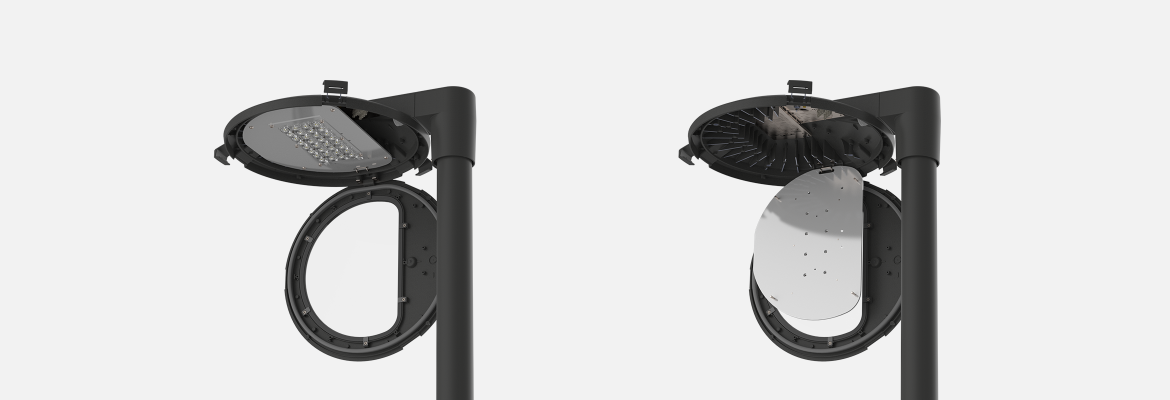TM66 Explained: An Interview with Bob Bohannon
September 2022
DW Windsor operates internationally. For the best experience in your region, please select the region most applicable to you.
September 2022
INTERVIEW
The traditional linear ‘make, use, dispose’ model of consumption is not only extremely wasteful but contributes to greenhouse gas emissions. However, within the lighting industry, the concept of circularity has recently gained increased attention with the development of CIBSE Technical Memorandum 66 (TM66), published by the Society of Light and Lighting (SLL) in 2021.
TM66 sets out by explaining the Circular Economy, defining its drivers and barriers, and then TM66’s Circular Economy Assessment Methods (CEAM) provides a unique assessment that quantifies how circular a lighting product is. Although still in a beta stage, through CEAM, a complex subject can be turned into a comprehensible star rating, giving manufacturers and specifiers targeted, useable, independent metrics to compare products and strive for improvement.
We recently sat down with Bob Bohannon, Head of Policy and Academy at The Lighting Industry Association (The LIA), to discuss the significance of TM66 and what this means for the industry.
Who developed TM66?
Published in October 2021, TM66 is a Technical Memorandum which serves to provide a framework for action and assessment for all within the lighting industry created by a team of volunteers for the Chartered Institution of Building Services Engineers (CIBSE) and the Society of Light and Lighting (SLL). You could say it was created by the industry for the industry.
What was the need for a new metric (TM66) to measure circularity in the lighting industry?
Simply, there just wasn’t a standardised measurement focused on the circular economy to complement other sustainability assessments. Prior to the introduction of TM66, different companies each had their own programme, whilst others had none at all. Therefore TM66 was about creating standardisation and transparency throughout the industry, as well as an accessible route to action for those setting out on their circular journey.
Before TM66, it was difficult for a specifier to compare the circularity of products from different manufacturers as they all had their own unique methods of measurement. TM66 allows specifiers to compare like for like, providing the industry with specific circularity metrics to adhere to and work with.

Bob Bohannon, Head of Policy and Academy at The Lighting Industry Association (The LIA), played a major role in the development of TM66 as project lead, working alongside Kristina Allison
How will this benefit the industry?
As the world increasingly realises the costs – both environmental and economical – of the resources we build into our products, the leading manufacturers have realised that full sustainability, not just a minimisation of energy use, is required. Our industry is increasingly adapting its designs and services to provide longevity in service via quality and repairability. TM66 is fundamental to giving manufacturers a way of clearly and fairly declaring their circular economy performance, providing them with a credible green marketing edge.
It also works by empowering specifiers, enabling them to make informed choices and choose fittings that have robust circularity credentials. Specifiers now have the ability to demand a circularity rating for either individual products or the wider project. This benefits both specifier and manufacturer, as the clear, independent TM66 rating gives a very justifiable and defensible measurement in a value engineering scenario.

On Downing Street in London, Windsor Street lanterns were retrofitted with LED light engines, helping to prolong their service life
Why should we strive to use this method to be more circular - why is TM66 so important?
Circularity is not a new concept. TM66 ensures accountability, providing a measure for companies like DW Windsor and other like-minded businesses that want to improve overall circularity across their portfolio. There is real demand from end-users to demonstrate circularity now for specific projects; this puts pressure on specifiers, and in turn on the manufacturers, to be mindful of how circular and sustainable the final product actually is.
What does the new assessment include that previous circular models did not?
TM66 provides a new metric for all to interpret the measurement of circularity... previously there wasn’t one. The new algorithm is the result of a cross-industry collaboration and a desire to provide practical guidance and tools to develop a circular, sustainable approach to lighting and building services engineering more broadly.
The earlier publication of CIBSE TM65 enables the embodied carbon of building services equipment to be calculated when no Environmental Product Declaration (EPD) is available. Using this tool as a supplement, TM65 provides engineers with a consistent approach to the way embodied carbon calculations for building services products are carried out and reported. TM66 for Circular Economy is the natural solution to complement TM65’s embodied carbon work.

Creating a circular economy in the lighting industry, CIBSE, 2021
What is a specifier's role in TM66?
If specifiers demand circularity ratings, more and more manufacturers will embrace TM66 as a measurement. As an industry, we have the ability to really make a difference by delivering smarter and more sustainable solutions.
Do you think there will be more circular models/metrics in the future?
TM66 CEAM Make is all about the product design and specification of circular economy lighting products. We have already released a ‘short form’ version, CEAM Design, which gives a subset of the most important questions a specifier can ask. After this will come CEAM Manage, which guides the Facilities Manager in how to keep their project sustainable into the future. From there, given its CIBSE heritage, the intention is to roll out to other building services.
Why is it important to use the TM66 model when creating new products?
It is important to note this model is voluntary, not mandatory. TM66 provides an accessible, low-cost measurement, offering assurance to manufacturers and specifiers alike. Providing credibility, this new metric embodies the industry’s ambition to be transparent while seeking to do things in the right way.
Are there any limitations to TM66?
Good question, sustainability is inherently complex; the more you analyse a product, a material or a manufacturing process, the more sustainability impacts you find. But to include all these might have made TM66 unusable. It thus trades complexity for effectiveness and useability; in doing so it does rely on the intelligence of its users.

Luminaires designed with replaceable components, like Daytona, are easier to maintain and upgrade
How do you think the industry will evolve in the context of the Circular Economy?
Ensuring products are built to last, can be upgraded as technology advances, and can be easily serviced and repaired is central to delivering a circular economy. The industry as a whole is immensely supportive of delivering circularity; this remains a long-term goal and is not a new concept.
Years ago, society was far less wasteful and more resourceful when it came to repairing items to increase longevity. However, we have since become a ‘throw away’ society, and it is not uncommon to dispense items rather than make the necessary repairs to bring them back to their former glory. Often lowering manufacturing costs to give the lowest initial capital cost created challenges to long service life. The concept of a circular economy is a real demonstration of going back to basics and taking better care of what we have.
Thank you to Bob for taking the time to share his thoughts with us. Find out more about the TM66 from the LIA here.